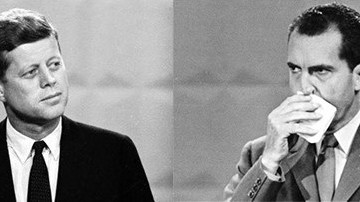It has become a common theme to link political change with the emerging communication technology of the day.
The invention of the printing press was seen as a key driver of the protestant revolution and subsequent religious wars in the 16th and 17th centuries.
The rise of political newspapers, pamphlets and the birth of the political cartoon following an accidental lapse in censorship laws at the turn of the 18th century led to ‘whiggish’ anti-establishment enlightenment thinking in England…and influenced the French and American revolutions.
In the 20th Century, the use of radio and TV radically changed how politicians communicated and were interpreted. In the run up to the 1960 US presidential election, the medium affected how the electorate saw the two candidates: Richard Nixon and JFK. Those listening on Radio, thought that Nixon won the debate while those watching on TV thought that Nixon looked shifty and nervous because he refused to wear make-up and looked sweaty and unshaven.
The internet changed things again in the 21st century. The 2016 US election and UK Brexit Referendum were notorious for the supposed influence of Facebook, although claims made by Cambridge Analytica on the ability to target key Facebook audience groups based on their Big 5 Personality Traits were subsequently discredited by several experts.
Eight years on and 2024 is being declared the year of TikTok. With more than 60 elections worldwide in 2024, TikTok is expected to become more influential, especially as platforms such as Facebook and X are downgrading news content in their content feeds.
The latest Reuters Institute Digital News Report 2024 showed a continued increase in the percentage of people using TikTok for news globally, and it is already seen to be shaping elections in countries like Indonesia and Argentina, while Facebook has declined significantly since 2020.

In the UK, the General Election on the 4th July was supposed to be the country’s first TikTok election. I would argue that this is not how it is panning out.
The influence of TikTok as a source of news is lower in the UK than in other countries. According to the Reuters Institute deep dive into the UK, just 15% of people use TikTok of which just 4% use the platform for news (half of the global number). Meanwhile 63% of people use Facebook of which 17% use it for news, while 53% use YouTube of which 13% use it for news.

There are also concerns in how much people trust TikTok compared to other platforms. 27% of people globally responded that that it was difficult to identify trustworthy news on TikTok – the worst of any platform.

The number of people that say they have seen false or misleading information across all media has increased, with politics being cited as the most misleading topic.
Research from cybersecurity experts at Cardiff University identified accounts, posting to the ITV TikTok account during the recent leader’s debate, which were exhibiting unusual behaviour. Half of the accounts they analysed were potential bots and just 20% were legitimate accounts. More than 3k followers of these accounts were traced to Nigeria.
TikTok has a much younger audience profile compared to other platforms such as Facebook and YouTube. According to the Digital 2024 Global Overview Report from Meltwater and We Are Social, 70% of TikTok’s advertising audience is under 35 and just 14% of TikTok’s advertising audience is over 45.

The younger audience is not where the political battleground is. From the most recent YouGov voting intention poll, Labour’s poll rating for the under 50s is 43% – a huge lead over the Conservatives who are at just 10%.

Younger people are also less likely to vote. From the same poll, 62% of over 50s say they are ‘certain to vote’ compared to just 45% of 18-24 year olds.
The real fight is for the over 50s. The latest YouGov poll generated headlines for being the first poll to show the infamous ‘cross-over’ where Reform got a higher poll rating than the Conservatives (with 19% compared to the Conservative’s 18% overall). Reform is getting an average of 23% of the vote for the over 50s.
This is why the Conservatives are spending so much effort appealing to the over 65s with messages like safeguarding pensions from taxation, as this is the only demographic that they are doing well with.
The dominance of Labour can also be seen in broadcast and press media. Polling company Redfield & Wilton Strategies has broken down voting attention by media consumption.

The right-leaning channel GB News is the only mainstream TV channel whose audience’s voting intention is not led by Labour. And even on GB News, more of its viewers are intending to vote Labour than Conservative.

Things are even more stark with national newspapers. Even consistently conservative supporting titles like the Telegraph, Daily Express and Daily Mail now have more readers that intend to vote Labour than the Conservatives and more that intend to vote Labour than Reform.
Will this dynamic put pressure on these newspapers to change their editorial lines over the next couple of weeks to better reflect their readers? There are already rumours that The Sun may back Labour, in a repeat of the 1997 election which contributed to the momentum that led to a Labour Landslide.
In 1992, in the previous election, Labour backed the Conservatives with the headline on election day saying “If Kinnock wins today will the last person to leave Britain please turn out the lights”. Following the Conservative victory, the Sun declared “It was the Sun wot won it” on their front page.
Individual newspapers on their own are less influential than they once were but they can often set the tone for the rest of the media ecosystem from broadcast to social media.
As former Prime Minister Boris Johnson said in his resignation speech: “the herd instinct is powerful and when the herd moves, it moves”.

